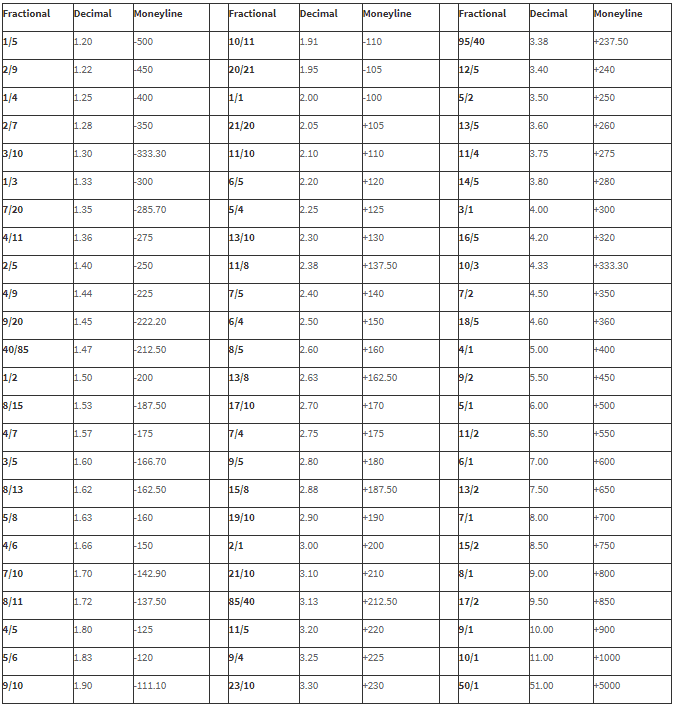5 6 Odds In Decimal
Posted : admin On 3/26/2022- Convert Fractional odds to probability. The most common form of odds are going to be decimal odds in the UK and here is how to convert decimal odds to probability.These are clear odds to read and for example the 6/5 odds on Liverpool from the example above means that for every 5 units you put on, you will receive 6 back as a profit.
- For example, when you use an odds converter to convert decimal 1.33 you get 1/3 fractional and -300 american but if you convert 1/3 to american you might see -303.03. While this conversion to -303.03 is actually correct, some bookies tend to refer to -300 when meaning the fractional 1/3 because it's easier for the punter to remember, while.

Betting odds explained
Betting odds can appear daunting at first glance but they are actually quite straightforward to calculate. We’ve devised a beginners guide to explain betting odds.

How do odds work?

When looking at the odds (price) of a horse, the two formats used are decimals and fractions. Betting exchanges operate in decimals, whereas fixed-odds betting firms generally operate in fractions.
Out of interest if you want to convert US odds to decimal odds, when it is a negative figure in this example -150, divide 100 by the quote and then add one. So it is 100 divided by 150 (don’t use the negative!) + 1 = 1.67 decimal odds. These are displayed in the format of 5.00, unlike fractional odds, your stake is already factored in. To get your potential return, multiply the odd by your bet. If the odd is displayed at 5.00, multiply this by your stake to calculate potential returns. Let’s explain some U.S. Horse racing odds examples: 6-5 odds. Spoken: 6 to 5 odds. Decimal odds show the amount that a bettor can win for every $1 staked. The number indicates the total return for the better, not just the profit as is seen in the other two odd formats. Here’s an example: The Stars are 1.714 in decimal odds (-140 in American).
When determining the returns of a fractional bet, the second number always suggests the stake and the first number denotes what the profit will be if the bet wins. Take 4/1 as an example. If you stake £1 on a horse, then you stand to win £4 if the selection wins the race, which excludes your initial stake. In contrast, the decimal format factors in the initial stake. Betting odds of 4/1 would equate to 5.0 in decimal terms, 5/1 would be 6.0, and so forth.
What Is 5/6 In Decimal
See the chart below for a breakdown of betting odds in both fractional and decimal format, showing forecasted returns to £5 level stakes for the key prices in a market.
Knowing your odds

6.5 Percent In Decimals
| wdt_ID | Fractional | Decimal | WIN RETURNS FROM £5 (inc. stake) |
|---|---|---|---|
| 1 | 1-2 | 1.5 | £7.50 |
| 2 | 4-7 | 1.57 | £7.86 |
| 3 | 8-13 | 1.62 | £8.08 |
| 4 | 4-6 | 1.67 | £8.33 |
| 5 | 8-11 | 1.73 | £8.64 |
| 6 | 4-5 | 1.80 | £9.00 |
| 7 | 5-6 | 1.83 | £9.16 |
| 8 | 10-11 | 1.91 | £9.55 |
| 9 | 1-1 | 2.00 | £10.00 |
| 10 | 11-10 | 2.10 | £10.50 |

6.5 As A Decimal
If you want to work out your winnings from a multiple bet such as an accumulator or lucky 15, you can use our betting calculator to find out instantly what you’ve won.